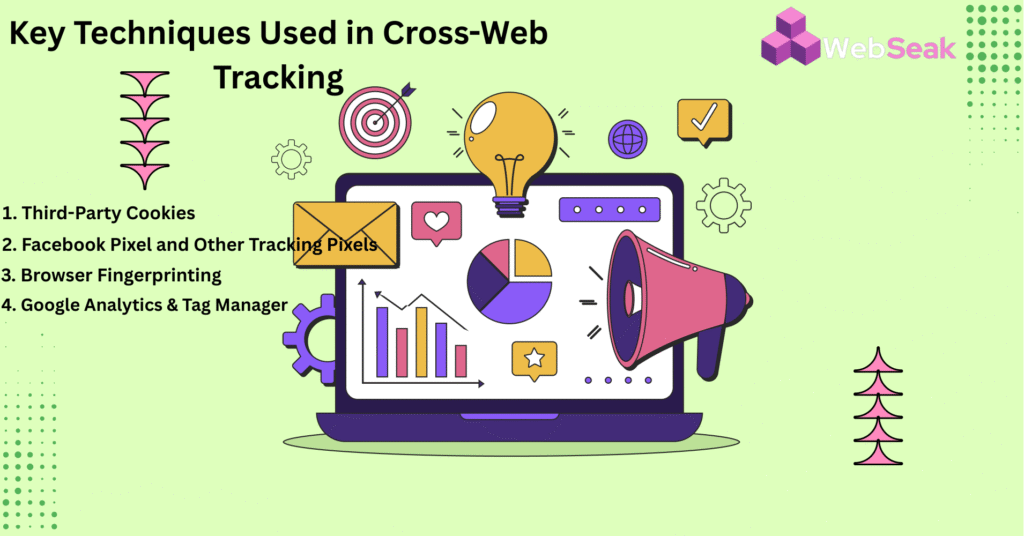
Introduction to Cross-Web Tracking in Digital Marketing
Digital marketing thrives on data. One of the most effective ways marketers understand user behavior is through tracking strategies that follow users across the web. These strategies enable businesses to deliver personalized experiences, optimize campaigns, and convert more leads.
But what is the digital marketing strategy that tracks users across the web? The answer lies in a mix of cookie-based tracking, third-party data collection, and retargeting techniques that form a core part of performance-driven marketing campaigns.
Table of Contents
Understanding User Tracking: The Basics
What Is User Tracking in Digital Marketing?
User tracking involves collecting and analyzing data about online behavior such as website visits, clicks, session durations, and preferences. This data helps marketers understand user intent and optimize their advertising efforts accordingly.
Why Track Users Across the Web?
Tracking users across different websites gives marketers a 360-degree view of customer behavior, enabling:
- Targeted advertising
- Better customer segmentation
- Higher conversion rates
- Improved user experience
The Main Strategy: Cross-Site Tracking
What Is Cross-Site Tracking?
Cross-site tracking, also called cross-web tracking, is a digital marketing strategy that allows companies to track users’ activities across multiple websites using cookies, pixels, and browser fingerprinting.
How It Works
When a user visits a site:
Key Techniques Used in Cross-Web Tracking

1. Third-Party Cookies
Third-party cookies are placed by domains other than the one the user is visiting. They help advertisers track users across websites and display personalized ads.
Example: A user visits an e-commerce site, looks at running shoes, and then sees ads for the same shoes on a news website.
2. Facebook Pixel and Other Tracking Pixels
Pixels are small snippets of code added to a website. They send back user interaction data to the advertiser.
Benefits of using pixels:
- Track conversions
- Build retargeting audiences
- Optimize ad performance
3. Browser Fingerprinting
This advanced technique captures device information (screen size, OS, browser version) to create a digital fingerprint that identifies users without cookies.
4. Google Analytics & Tag Manager
Google’s ecosystem allows marketers to monitor and analyze cross-site behavior via UTM parameters, event tracking, and remarketing tags.
Benefits of Tracking Users Across the Web
1. Precision Targeting
Understand where users drop off, what interests them, and which content leads to conversions.
2. Personalized Marketing
Deliver personalized messages and offers to the right user, at the right time, on the right platform.
3. Effective Retargeting
Track abandoned carts or incomplete sign-ups and nudge users through remarketing ads.
4. Campaign Optimization
With more data, marketers can fine-tune ad creatives, placements, and budgets for better ROI.
Tools Used for Cross-Web User Tracking
| Tool | Purpose |
|---|---|
| Google Ads Remarketing | Retarget users with search/display ads |
| Meta (Facebook) Pixel | Create custom audiences and retarget |
| Hotjar | Understand user interaction with heatmaps |
| HubSpot | CRM and marketing automation with tracking |
| Segment | Collect, manage, and route data |
Privacy Concerns and Ethical Considerations
Is Cross-Site Tracking Legal?
Yes, but under strict guidelines. Laws such as GDPR (EU), CCPA (California), and other data protection acts require:
- Clear user consent
- Transparency in data collection
- Options to opt-out
How to Maintain Ethical Tracking?
- Display cookie banners and privacy policies
- Use first-party data where possible
- Avoid selling data to third parties without consent
- Give users control over data sharing
Future of Cross-Web Tracking: The Cookieless Era
1. Phasing Out Third-Party Cookies
Google Chrome, the most used browser, is moving to phase out third-party cookies, altering the landscape for advertisers.
2. Rise of First-Party Data
Marketers are now focusing on collecting data directly from their users through forms, subscriptions, and interactions.
3. Contextual Advertising
Instead of tracking users, contextual advertising focuses on matching ads with the content the user is currently viewing.
4. Universal IDs
Solutions like Unified ID 2.0 are being developed to replace cookies and maintain user privacy while still allowing tracking.
Conclusion: What Should Marketers Do Now?
Cross-web tracking is a powerful tool in the digital marketer’s arsenal. However, with growing concerns over privacy and changes in browser policies, businesses must evolve.
The future lies in ethical tracking, first-party data, and smart technologies that respect user privacy while delivering results.
By understanding this digital marketing strategy, you can build more impactful, compliant campaigns that foster trust and generate high ROI.
Need Help Tracking Users Across the Web?
At Webseak, we help businesses implement powerful, privacy-conscious tracking strategies that boost conversions and build loyal audiences. From Google Ads to retargeting, we cover it all.





